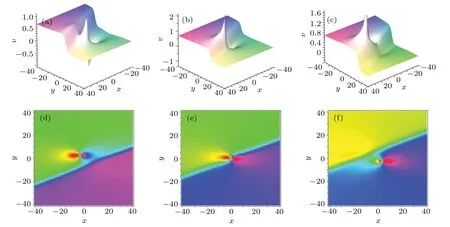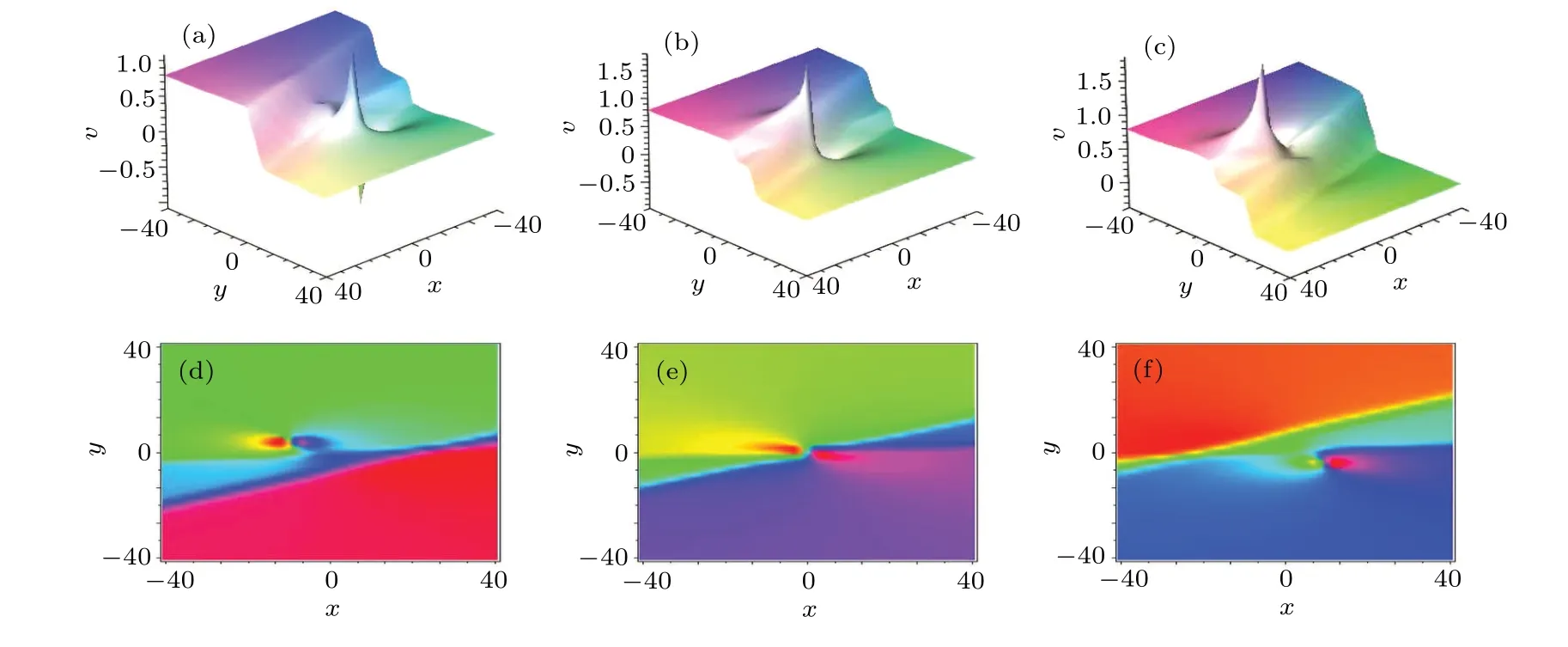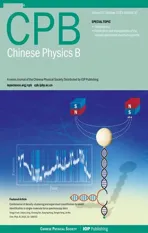Trajectory equation of a lump before and after collision with other waves for generalized Hirota-Satsuma-Ito equation
2023-11-02YarongXia夏亚荣KaikaiZhang张开开RuoxiaYao姚若侠andYaliShen申亚丽
Yarong Xia(夏亚荣), Kaikai Zhang(张开开), Ruoxia Yao(姚若侠), and Yali Shen(申亚丽)
1School of Information and Engineering,Xi’an University,Xi’an 710065,China
2School of Science,Xi’an University of Architecture and Technology,Xi’an 710055,China
3School of Computer Science,Shaanxi Normal University,Xi’an 710062,China
4Maths and Information Technology School,Yuncheng University,Yuncheng 044000,China
Keywords: Hirota bilinear method,long wave limit,hybrid solutions,trajectory equation
1.Introduction
Nonlinear partial differential equations (NLPDEs) play an important role in fluid mechanics, plasma, quantum field theory, and so on.[1-3]The exact solution of NLPDEs can describe various physical properties exhibited by the equation, therefore, the search for effective methods of solving NLPDEs has received a lot of attention.Until now,many useful methods have been proposed, such as Darboux transformation,[4,5]B¨acklund transformation,[7]inverse scattering transformation,[8]variable separation method,[9,10]Hirota bilinear method,[11-13]etc.Among them, Hirota bilinear method is most studied by many scholars owing to its simplicity and directness.In Refs.[14-19], the lump solutions to many NLPDEs were presented through Hirota bilinear method.Lump wave is a special rational function wave,which is localized in all directions of space.Manakovet al.gave the analytical expression of the lump solution when he studied the rational solution of the KP equation[20]firstly.In recent years, the interaction between lumps and solitons, breathers,rogue waves, etc.has become a research focus in the soliton theory.Liet al.investigated the high-order lumps,breathers,and hybrid solutions of the(2+1)-dimensional fifth-order KdV equation.[21]Wang constructed lump and interaction solutions to the(2+1)-dimensional Burgers equation in Ref.[22].Zhouet al.studiedn-lump and interaction solutions of localized waves to the (2+1)-dimensional generalized KDKK equation in Ref.[23].In Ref.[24], Zhanget al.provided the trajectory equation and phase expression of a lump before and after collisions with line and breather waves based on the hybrid solutions of the KP equation.In Ref.[25],Zhanget al.derived a new class of nonlinear superposition between lump waves and other waves of KPI equation.Xiaet al.discussed the trajectory equation of a lump before and after collisions withn-line andn-breather waves for (2+1)-dimensional Sawada-Kotera equation in Ref.[26].
In this paper, we will study the following (2+1)-dimensional GHSI equation
whereρi(i=1,..., 4) are arbitrary constants.Equation (1)is an important model in shallow water wave theory, which is proposed by Hirota and Satsuma via a B¨acklund transformation of the Boussinesq equation, it is an extension of the Hirota-Satsuma shallow water wave equation.In Refs.[27-31], the authors have studied Eq.(1) from different perspectives, mainly including multi-soliton solution, lump solution,breather solution, hybrid solutions, etc.However, there is no relevant research on the trajectory equation before and after the interactions of the GHSI equation with other nonlinear waves until now.This will be the main work of our paper.
The rest of this paper is organized as follows: In Section 2, then-soliton solution of Eq.(1) is constructed via the Hirota bilinear method.In Section 3, by employing the long wave limit method,the hybrid solutions consisting ofm-lump andn-soliton wave,m-lump, andn-breather wave for Eq.(1)are obtained.In Section 4, the trajectory equation and phase change of the lump wave before and after collisions withnsoliton andn-breather wave are given.The last section contains a discussion and summary.
2.The N-soliton solution for generalized Hirota-Satsuma-Ito equation
Through the dependent variable transformation
equation(1)can be converted into the following bilinear equation:
whereτ=τ(x,y,t),theDis the bilinear differential operator defined by
That is,ifτis a solution to Eq.(3),thenv=2(lnτ)xis a solution to Eq.(1).
Based on the Hirota bilinear method and transformation(2),then-soliton solution of Eq.(1)is
wherepi,qi,ωi, andφiare arbitrary constants, ∑µ=0,1represents the sum of all possible combinations ofµi=0,1 (i=1,...,N).
3.The M-lump solution and hybrid solutions for generalized Hirota-Satsuma-Ito equation
The long wave limit method is an effective method to construct lump solution for nonlinear differential equations.In this section, we will explore this method to the GHSI equation.
3.1.The M-lump solution for generalized Hirota-Satsuma-Ito equation
Taking the long wave limit for then-soliton solution(5)
we can get them-lump solution of Eq.(1)as
with
WhenN=2,M=1 for Eq.(6)and Eq.(7),the following 1-lump solution can be derived:
WhenN=4,M=2,the 2-lump solution of Eq.(1)is
3.2.Hybrid solutions for generalized Hirota-Satsuma-Ito equation
When we take the following partial long wave limit on Eq.(5),that is constraints
the hybrid solution betweenm-lump andn-soliton of Eq.(1)can be derived.
For example,whenm=1,n=1,
equation (12) denotes the hybrid solutions of 1-lump and 1-solitons,where
Whenm=1,n=2, we can yield the hybrid solutions of 1-lump and 2-solitons as
whereKijsatisfies Eq.(13).
Similarly,taking the following partial long wave limit onn-soliton solution(5):
the hybrid solutions betweenm-lump andn-breather wave of Eq.(1)can be obtained.
For example,whenm=1,n=1,the hybrid solutions of 1-lump and 1-breather are
It is easy to found that although equations (14) and (16)have the same expression form, they represent completely different hybrid solutions due to different constraints conditions(11)and(15).
4.Trajectory equation of a lump before and after collision with other waves for generalized Hirota-Satsuma-Ito equation
According to Eq.(7), the 1-lump solution of the (2+1)-dimensional GHSI equation can be expressed as
whereθiandKi jare given by Eq.(8).Through the extreme value theorem of binary functions,we can obtain the parameter equation of the wave peak and valley of the 1-lump solution for Eq.(1)as follows:
the parametric equations (18) and (19) can be converted into the following general form
From Eqs.(20)and(21),we know that the lump wave moves along a straight line,and the wave speed is
The height of peak and the depth of valley are respectively
It is well known that the research on the motion trajectory of the lump wave usually refers to study its peak motion.In order to better understand the motion behavior of the 1-lump wave, we select the parametersρ1=2,ρ2=2,ρ3=3,ρ4=3,P1=1+(3/4)I,P2=1-(3/4)I,Q1=-1/2+I,Q2=-(1/2)-I,the following image simulations are shown in Fig.1.
4.1.Trajectory equation of 1-lump before and after collisions with n-soliton
In this subsection, with the help of the motion trajectory of a single lump, we mainly study the trajectory equation of 1-lump before and after collisions withn-soliton.In order to give a concise form of the trajectory equation before and after collisions,we refer to the following two function tokens:
4.1.1.Trajectory equation of 1-lump before and after collisions with 1-soliton
To proceed,with the help of expression(12),we propose the trajectory equation of 1-lump before and after collisions with 1-soliton for Eq.(1)by Theorem 1,and the related proof is given.
Theorem 1 If the hybrid solution between 1-lump and 1-soliton for Eq.(1)can be represented as Eq.(12),and
then, before and after the collisions of 1-lump and 1-soliton,the trajectory equations for the lump wave are
with
the phase change of the lump wave is
However,before and after the collisions,the height and depth of the lump wave do not change,they still satisfy Eqs.(23)and(24).Where sign(x)is a symbolic function,x-,y-andx+,y+are the trajectory equations of the lump wave before and after collisions with solitons respectively.
Proof Applying the following constraints:
to the second equation of Eq.(12),it can be transformed into
where
For Eq.(31),we first discuss the case ofλ3>0.
Whenλ3>0 andt →-∞,equation(31)can be reduced to the following form:
Whent →∞,due to the invariance of the solutionv=2(lnτ)x,we multiply the expression exp(-λ3t-η3)to the right side of Eq.(31)will get
Solving Eq.(30),c1andc2can be obtained below:
Substituting Eq.(35)into Eqs.(33)and(34)leads to
Here,bothτ-andτ+satisfy the bilinear equation(3).Therefore,before and after collisions,the trajectory equations of the lump wave can be written as
The general forms of Eq.(37)are
Substitutingx-,y-andx+,y+into the solutionv=2(lnτ)x,it can be verified that the height and depth of the lump wave remain unchanged.For the case ofλ3<0, the proof process is similar to the case ofλ3>0,it is omitted here.
From Theorem 1, we find that the collision between 1-lump and 1-soliton is elastic whenλ3/=0.In order to better characterize Theorem 1, let the parametersρ1=2,ρ2=2,ρ3=3,ρ4=3,P1=-1/2,P2=-1/2,Q1=I,Q2=-I,p3=1/3,q3=-5/6,φ3=0, the corresponding diagrams plotted in Fig.2.

Fig.2.Evolution behaviors of hybrid solution of 1-lump and 1-soliton for Eq.(1)at t=-10,0,10:(a)-(c)three-dimensional(3D)plots;(d)-(f)density plots.
4.1.2.Trajectory equation of 1-lump before and after collisions with 2-soliton
In this part,the trajectory equation of 1-lump before and after the collisions with 2-soliton is discussed from the 4-soliton solution,and the trajectory equation of 1-lump colliding withn-soliton is given.
Theorem 2 If the hybrid solution between 1-lump and 2-solitons for Eq.(1)can be represented as Eq.(14),and
then,before and after collisions,the trajectory equations of the lump wave are given below:
whereβiandγiare determined by Eq.(28).Before and after collisions,the phase change of the lump is
But the height and depth of the lump do not change and are consistent with Eqs.(23)and(24).
Proof By employing the condition(30),the second equation of Eq.(14)can be converted into
whereχiandηisatisfy Eq.(32).
For Eq.(42), we need to consider the following casesλ3>0,λ4>0;λ3>0,λ4<0;λ3<0,λ4>0, andλ3<0,λ4<0.Here,we only discuss the first two cases,and the others can be discussed in the same way.
(i)Whenλ3>0,λ4>0,according to the method in Theorem 1,whent →-∞andt →∞,equation(42)can be written as
the trajectory equations of the lump wave before and after collisions are given below:
The general forms of Eq.(44)are as follows:
By Eq.(45), we can yield the value of phase change in Eq.(41).Substituting Eq.(44) intov=2(lnτ)x, the height and depth of the lump wave do not change.
(ii)Whenλ3>0,λ4<0,we have
The general equations corresponding to Eq.(47)are
The values of Eq.(41)of the phase change can be obtained by Eq.(48).Substituting Eq.(47)intov=2(lnτ)x,we can verify that the height and depth of the lump wave do not change.
To better explain the Theorem 2, by taking a set of parametersρ1=2,ρ2=2,ρ3=3,ρ4=3,P1=I/2,P2=-I/2,Q1=1+I/4,Q2=1-I/4,p3=1/4,p4=1/7,q3=-3/4,q4=-2,φ3=0,φ4=0, the collision diagrams of a lump wave and two-kink soliton can be given in Fig.3.
By further generalizing Theorem 1 and Theorem 2, the trajectory equations before and after collisions of 1-lump andn-solitons can be obtained below.
Theorem 3 Ifλi/=0, (i=3, 4,..., 2+n), then before and after 1-lump wave collidings withn-solitons, the trajectory equations of the lump wave are as follows:
The phase shift of lump wave is

Fig.3.Evolution behaviors of hybrid solution of 1-lump and 2-soliton for Eq.(1)at t=-30,0,30: (a)-(c)the 3D plots;(d)-(f)density plots.
4.2.Trajectory equation of 1-lump before and after collisions with n-breather
In this subsection, the motion trajectories and phase expressions of the lump wave in the hybrid solutions of 1-lump and 1-breather,1-lump andn-breather will be investigated.
Theorem 4 If ℜ(λ3), ℜ(λ4)/= 0, then the trajectory equations of the collisions between 1-lump and 1-breather are
and the phase shift of the lump wave is
Comparing Theorem 2 and Theorem 4,their proof procedures are similar except for different constraint conditions, so the proof process will not be given here.In order to better describe the motion trajectory of 1-lump and 1-breather before and after collisions,the collision diagrams can be given in Fig.4 by selecting parametersρ1=2,ρ2=2,ρ3=3,ρ4=3,P1=3+I,P2= 3-I,Q1= 1+6I,Q2= 1-6I,p3= 3I,p4=-3I,q3=5/2,q4=5/2,φ3=0,φ4=0.
Next,we further extend Theorem 4 to the case of 1-lump collidings withn-breather.The specific content is shown in the following Theorem 5.
Theorem 5 If ℜ(λi)/=0,(i=3,4,...,2+2n),then, before and after collisions of a lump andn-breather the trajectory equations of the lump wave are
and the phase shift of the lump wave is
5.Summary and discussion
In this paper, the trajectory equations of a lump before and after collisions with other waves for generalized Hirota-Satsuma-Ito equation are studied.Firstly, we start from the multi-soliton solution of the (2+1)-dimensional GHSI equation, many different types of mixed solutions of the GHSI equation are derived,such as the interaction between the lump solution and the line-soliton solution, the lump solution, and the breather solution.Secondly, under the constraint conditionsλi/=0, ℜ(λi)/=0 the trajectory equations of the lump wave before and after collisions withn-soliton(Theorm 3)andn-breather(Theorm 5)are proposed,and we have proved that the collision between lump and other waves are elastic,and the height and depth of the lump wave do not change.However,what does it mean whenλi=0,ℜ(λi)=0? It will be shown in our subsequent research.
Acknowledgements
Project supported by the National Natural Science Foundation of China (Grant Nos.12001424 and 12271324), the Natural Science Basic Research Program of Shaanxi Province,China (Grant No.2021JZ-21), the Chinese Post Doctoral Science Foundation (Grant No.2020M673332), and the Three-year Action Plan Project of Xi’an University (Grant No.2021XDJH01).
猜你喜欢
杂志排行
Chinese Physics B的其它文章
- Single-qubit quantum classifier based on gradient-free optimization algorithm
- Mode dynamics of Bose-Einstein condensates in a single-well potential
- A quantum algorithm for Toeplitz matrix-vector multiplication
- Non-Gaussian approach: Withstanding loss and noise of multi-scattering underwater channel for continuous-variable quantum teleportation
- Detection of healthy and pathological heartbeat dynamics in ECG signals using multivariate recurrence networks with multiple scale factors
- Rucklidge-based memristive chaotic system:Dynamic analysis and image encryption
